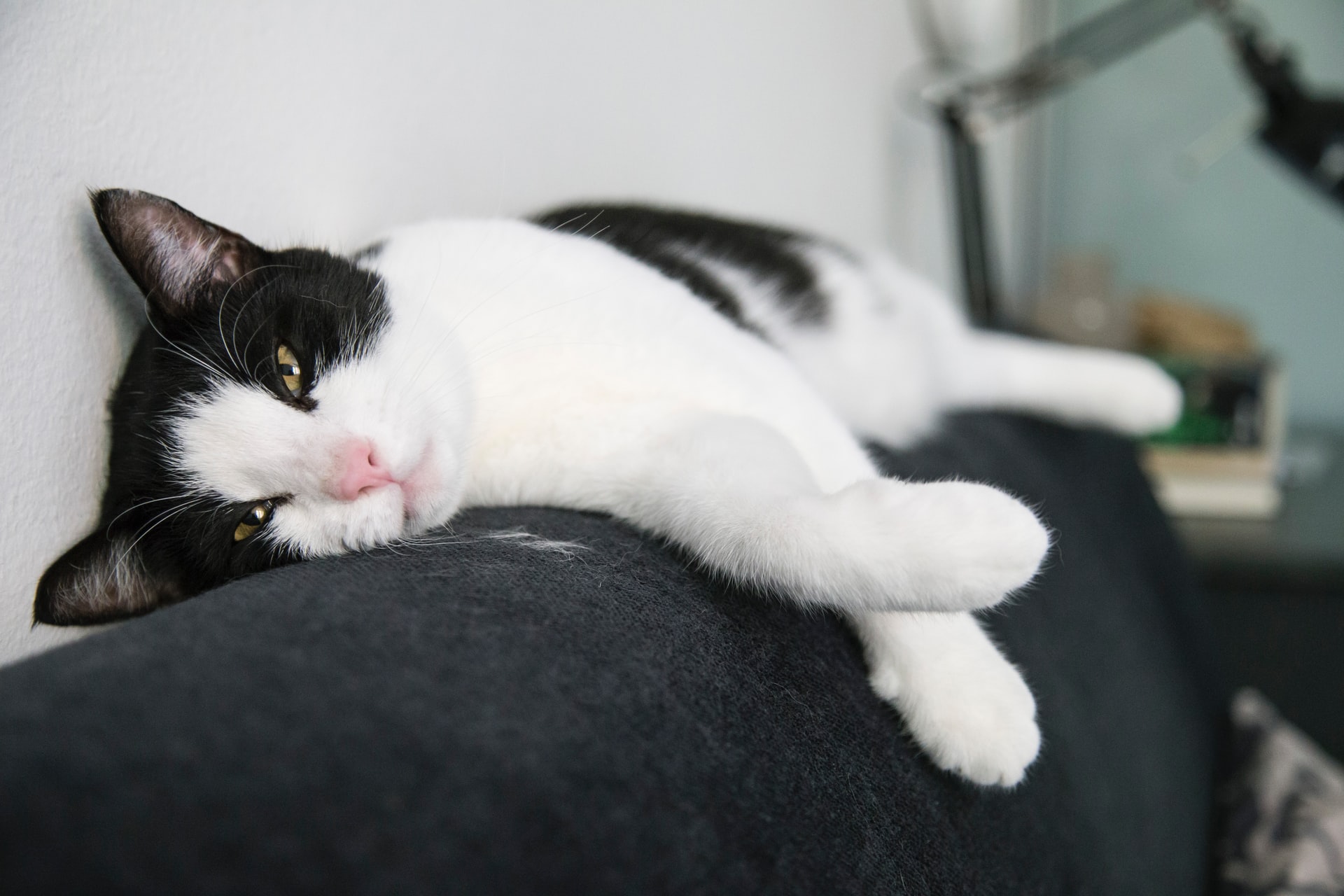For cats, scratching is one of their primal, instinctual urges, and it is not just a kitten behavior; it’s something felines do their whole lives. As a cat parent, you love your furry friend to pieces, but those cutting claws can shred your fine furniture and make you lose your patience.
You have probably tried everything you can imagine to make it stop but still had no luck. We have gathered up some cat experts to understand why your cat is scratching and try to correct the behavior to help them find alternatives that satisfy their need to flex their claws and keep your furniture and home safe.
Why do cats scratch?
There’s more to a cat’s fluffy claws and paws than sharpness and cuteness! Cats use scent glands in their paws to help mark their territories. Claw maintenance is also of the upmost importance to cats, scratching anything available not only to sharpen their claws but also to remove the outer layer as part of their natural instinct to climb and protect themselves. When scratchers are not in the home, they’ll often resort to furniture. Cats do not respond well to punishments; to save your furniture, invest in scratchers to place in their favorite spots around the house.
Jenna Murrell at Redbarn
How do I know if my cat’s scratching is anxiety-related?
When determining the cause of any behavior, it is important to look at triggers. Are there patterns to your cat’s scratching, like particular situations, times of day, or locations? Cats have a natural need to scratch which isn’t necessarily related to stress or anxiety. You may notice your cat scratches after waking up or when you come home. In these cases, your cat just needs an appropriate place to scratch. If instead, your cat looks for someplace to scratch after seeing the neighbor’s cat or after a conflict with another cat in the home, this could indicate stress. Scratching is a way of communicating with other cats through pheromones; a cat that routinely scratches after seeing or interacting with another cat may be feeling anxious about that situation.
Jessica Char at Feline Engineering
Can I declaw my cat?
If you are frustrated with your cat scratching your furniture, it’s likely you’ve looked into the issue and come across ‘declawing’. While this may seem like a convenient solution to the problem and sounds as harmless as trimming nails, it’s actually a serious procedure that involves cutting the bones the claws grow from.
The most frequent type of declawing is called an onychectomy which is essentially an amputation of the last joint of your cat’s ‘toes’. This is inhumane and unethical. Of course, there are cases where this type of surgery is medically necessary, but if you are just worried about your cat scratching the furniture, please consider other solutions like clipping your cat’s nails regularly or covering your cat’s favorite places to scratch with double-sided sticky tape.
Emma Williams at The Idle Cat
How can I trim my cat’s nails?
In order to get your cat used to nail trimmings, you need to desensitize them to not only touching their paws but also to the feeling of the trimmer. Try when they are really sleepy, sleeping, or after vigorous play to just touch/squeeze their paws. Allow them to smell and see the clippers without using them and then gradually just touch the clippers to their paws/nails. Once you are ready to actually clip nails, please watch out for the wick. Act like it’s no big deal, don’t feel scared or anxious and it’s ok if you are only able to do one or two. Come back and try more later. Never force, restrain, or make it a stressful and fearful event for your cat.
Check out this fantastic video from our friends at The Humane Society of Sedona https://www.youtube.com/watch?v=YbtLbOyx9Hk
Shani Campbell at The Humane Society of Sedona
What are cat nail caps and are they safe?
If you are struggling with a stubborn cat scratching habit and still find him or her being destructive, there is a pretty simple solution that is even a little fun: plastic claw tips that render their claws useless and provide a rainbow of color!
There are a few brands of these kinds of tips, and they come in fun colors (that’s the “fun” part of the solution). Just trim down your cat’s nails a bit first, so they are stubby rather than sharp. Then dab a little glue of the glue (usually included) into the claw tip and pop it on a claw. Hold it there for a couple of seconds, and that’s it! Then repeat.
Be sure to wipe your fingers with a wet cloth between each tip, so if any glue gets on you, you don’t start sticking to everything- or have your fingers glued together. You don’t want to get glue on your kitty’s fur either, which will just be messy for you both.
After a few weeks, the tips will eventually start to fall off, but if you find them on the floor, you can actually reuse them a few times. As well, the glue is just a typical grocery store “super glue,”- so you can get it anywhere if it dries up in between.
If you’re worried about superglue being pet safe, you may be surprised to know it was actually invented specifically for use on the body/ in surgery as an alternative to other closures- so you don’t need to worry about it being toxic.
Your kitty may respond to their new colorful manicure by walking a little funny for a few minutes, but within a short period, he or she will adjust. Next time they go to claw your furniture, they will be surprised to find out it doesn’t work!
These tips can also be used in medical situations where a cat has a flea infestation or allergy, for example, and is scratching themselves raw. They will still scratch (and you need to work on resolving the problem with your vet), but with the tips, they can’t dig into their skin and claw themselves.
-JME Thomas at Motley Zoo Animal Rescue
Should I buy a scratching post, a condo, a cardboard scratcher, or a tree?
That’s an interesting question and the living being that can answer that meows! I wish it was an easy answer, but here’s what my experiences say to date… Mr. Theodore is probably the most interesting pet I’ve ever had. That’s no offense to Cinnamon May, or Miss Lucy of course!
He is extremely smart, lovable, a little demanding, and quite peculiar. That last one is where I’m going to focus. I’ve bought tons of toys: from lasers to toys that turn on automatically, that are attached to strings, etc. The ones you think he is going to love, he doesn’t even touch them.
For Theo, he has a cat condo, and it has a scratching post built onto the legs of the perches. He’s never scratched it once. He never scratches the carpet, my furniture, or anything else. I keep one scratcher hanging from the door, and he’ll give that a good pull and stretch, but for some reason, HE LOVES a fresh cardboard scratcher when I put it flat on the ground.
Bottom line, it’s up to the boss of the house to pick, so it might take experimenting. I’d start with low-cost cardboard scratchers, but you can’t go wrong with a cool condo looking out a window!
Paul D. Cannella at The Original Poop Bags® & Catfidence
What’s the best material for a Scratching Post?
There are no “best” materials for scratching posts. Two factors should be considered: material and form factor. Different cats prefer different types.
Common materials include cardboard, carpet, and sisal. Form factors include horizontal flat-on-the-floor cardboard scratchers, post scratchers, cat tree scratchers, and incline scratchers. If your cat is continuously scratching the carpet, he’ll probably go for the carpet scratchers. Most commonly you’ll find these scratchers on cat trees or pole scratchers. If you’re handy and have some carpet remnants, a post scratcher is a reasonably easy DIY project to build from scratch.
Sisal scratchers are most often built on posts, either as standalone scratchers or as part of a cat tree. There are some that you can hang on doorknobs, etc., but those are not a good choice if the bottom is not anchored. When the posts get shaggy, it’s usually a simple matter of ripping off the old sisal and wrapping it with new. They tend to last much longer than cardboard floor scratchers. Higher-end sisal scratchers can be close to indestructible.
In addition to considering material and form factors, it’s important that the scratcher is a sufficient size for your cat. It should be large enough that the cat can stretch out while scratching, and solid enough that it doesn’t risk tipping.
Karen Nichols at Mousebreath Magazine
Are cat wall shelves a good furniture alternative for my cats?
Yes, cat wall shelves can be great cat furniture alternatives. It’s in fact my favorite way to go, especially when your home may be on the smaller/cozier side. Having shelves of different heights allows your cat to embrace his/her kingdom. Some cats love to be the king/queens of the jungle and be at the very top of the veiling looking down at all their subjects, while others love to be at eye level with you. Whichever your cat likes to do, you can’t go wrong. Adding textures like carpet or rope to the shelving (takes a little DIY in some cases) will add an extra layer of fun and adventure when your cat clubs up the walls, literally. The more your cat can feel like it can do cat-like things inside the house (such as climbing and jumping) the happier your cat will be.
Edgar Lopez at Michelson Found Animals
Is there any product that can keep my cat away from my furniture?
There are a variety of products on the market designed to keep cats away from furniture. Anti-scratch training tape is a popular choice that can prove to be effective. However, it won’t deter every cat, and some cat owners don’t like it as it can compromise the aesthetic of their furniture. Another solution could be to make your own apple cider vinegar spray by diluting apple cider vinegar with water. It acts as a natural deterrent as most cats absolutely can’t stand the smell of vinegar!
Angela Stringfellow at Pet Life Today
How can I make my furniture unappealing to my cat with everyday items?
It’s part of a cat’s natural behavior to scratch and he will scratch your furniture if you don’t have anything more suitable for him to use. From a very early age, kittens can be trained to use a scratching post. As part of the paraphernalia that you should have in place ready for when you bring your kitten or cat home, you should include a tall, sturdy, scratching post. Some cats prefer to scratch horizontally, and you can buy scratching ‘trays’ which do the trick.
Pauline Dewberry at The Daily Mews
How can I protect my furniture from my cat?
Veterinarians, behaviorists, and trainers agree that there are several ways to help better manage the damage while allowing your cat to get the stretching and clawing she needs.
Purchase a scratching post. Place the scratching post near your cat’s favorite targeted area. When she starts to scratch the furniture, gently remove her paws from the furniture and place them on the scratching post. Reward her with treats for scratching the post. Over time, move the scratch post further away from the furniture until the post becomes her new favorite scratching target.
- You can use ClawGuard Furniture Shields or ClawGuard Protection Tape to cover the targeted areas your cat is clawing. This will help to block the scent to which she is attracted and will protect the furniture from further damage. Use ClawGuard in conjunction with a scratch post for better results.
- Use treats to reward your cat for good behavior. Positive reinforcement is more impactful than negative punishment.
- Consider nail caps. This will allow your cat to scratch without compromising or damaging furniture.
- Clip her nails. Have her nails trimmed during routine veterinarian visits or purchase nail clippers with a safety guard specifically designed for cats.
ClawGuard does not condone using water spritzers for behavior management nor declawing.
Kevin Dixon at CLAWGUARD
How can I attract my cat to its own furniture?
Cat’s are attracted to things that allow them to play out natural instincts such as climbing, stalking, playing, stretching, resting, and observing from safe, elevated vantage points. If you provide cats with an environment that promotes these behaviors, they will naturally be attracted to them. All too often, cat products are designed for the benefit of the owner, rather than the cat, and that rarely works in practice. Make sure that you focus on the needs of the cat first and foremost, and let nature take its course. Some initial encouragement using cat treats can shorten the adoption process but cats will usually do things in their own time.
Andy Sutton at Catipilla
Will my cat stop scratching my furniture if I shout its name?
It is highly unlikely that your cat will stop scratching your furniture if you yell its name – or obscenities, or any other words. Cats need to scratch for territorial marking with the scent glands between their toes, for a backstretch, and for a nail trim. Studies show that scratching is more frequent in multi-cat homes. Yelling at your cat will only frighten it and cause relationship erosion. Be sure to provide your cat with a variety of appropriate scratching devices that have different textures and are both horizontal and vertical.
Molly DeVoss at Cat Behavior Solutions
How long will it take for my cat to stop scratching my furniture?
Each cat and situation is different, so there’s no guaranteed time period to successfully stop your cat from scratching the furniture. Therefore, the key to success is being consistent in redirecting the cat’s attention away from your furniture to something more appropriate to scratch. Be sure to reward the behavior you want with treats and praise in order to reinforce it. With patience and consistency, your cat will associate their cat tree or scratching post as a more desirable object to scratch than your furniture
Pam Roussell Purrrfectly Holistic
Understanding your cat’s behavior might not be as hard as it seems. It might take time to teach your kitty where she can scratch, but it’s worth it. Be patient as you’re trying to find the texture your cat prefers to claw and keep in mind that it might like some textures above others.
How home insurance can safeguard your cat and furniture
Cats bring joy and companionship to our homes, but their natural instincts, such as scratching, can sometimes cause frustration. As you work to protect your furniture from your feline friend’s claws, it’s important to consider how home insurance can play a role in ensuring both your cat’s well-being and the integrity of your belongings.
Pet liability coverage: Some home insurance policies offer coverage for pet-related incidents, including damage caused by your cat. If your cat’s scratching results in harm to a visitor or damage to someone else’s property, having pet liability coverage can help mitigate potential legal and financial consequences.
Personal property coverage: Home insurance typically includes coverage for personal property within your home. This extends to items like cat beds, scratching posts, and other belongings that contribute to your cat’s well-being. In the event of covered perils such as fire or theft, this coverage can help you replace these essential items.
Alternative solutions coverage: If you invest in alternative solutions to deter your cat from scratching furniture, such as claw caps or anti-scratch training tape, some home insurance policies may provide coverage for these preventive measures. Consult with your insurance provider to understand the extent of coverage for such items.
While home insurance can provide financial protection in certain situations, it’s essential to address the root cause of your cat’s scratching behavior. Implementing advice from cat experts, such as providing appropriate scratching alternatives, using cat furniture, and employing positive reinforcement techniques, can contribute to a harmonious living environment for both you and your feline companion.
In conclusion, protecting your home from cats involves a combination of proactive measures, understanding your cat’s natural instincts, and considering the role of home insurance in safeguarding your pet and possessions. By taking a comprehensive approach, you can create a home where your cat feels content, and you have peace of mind knowing that your furry friend and belongings are protected.




